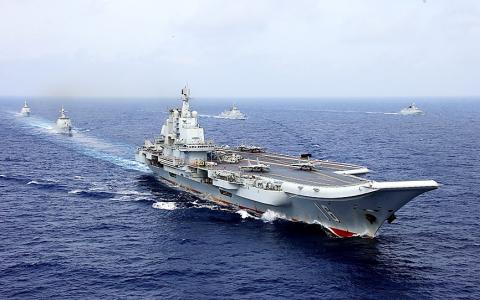The Chinese People’s Liberation Army (PLA) plans to be fully equipped to carry out a full-scale resumption of hostilities against Taiwan by 2020, a Ministry of Defense report released yesterday showed.
Possible PLA strategies against Taiwan include combined arms tactics, naval blockades, artillery shelling and amphibious assaults, the 2018 Report on the People’s Liberation Army said.
The Chinese Communist Party (CCP) has not renounced its intention to conquer Taiwan through military means, and its adherence to the “one China” principle, denial of the “one China, one Taiwan” system and refusal to acknowledge the de facto sovereignty of the Taiwanese government presents an ever-growing threat to the Taiwanese military, the report said.

Photo: Reuters
The PLA drafts its plans for minimal losses and maximum efficiency, and would aim to conduct a lightning-fast invasion aimed at a swift conclusion of military operations, it said.
China sees unification with Taiwan as the unwavering “duty” of the CCP, it added.
A declaration of independence, domestic instability, receiving or developing nuclear weapons, a delay in political talks geared toward unification, foreign intervention in Taiwan’s internal affairs or the deployment of foreign forces to Taiwan are possible flashpoints that could lead to a Chinese invasion of the nation, the ministry said.
PLA exercises over the past few years have been aimed at preparing for war against Taiwan, but the Taiwan Strait remains a hard-to-overcome natural defense due to the PLA Navy’s lack of transport vessels and inadequate logistics capability, the report said.
The PLA is expected to look into acquiring the capability to launch joint landing operations, the report said, adding that the ever-growing threat the PLA poses to Taiwan bears close monitoring.

Tropical Storm Gaemi strengthened into a typhoon at 2pm yesterday, and could make landfall in Yilan County tomorrow, the Central Weather Administration (CWA) said yesterday. The agency was scheduled to issue a sea warning at 11:30pm yesterday, and could issue a land warning later today. Gaemi was moving north-northwest at 4kph, carrying maximum sustained winds near its center of up to 118.8kph and gusts of 154.8kph. The circumference is forecast to reach eastern Taiwan tomorrow morning, with the center making landfall in Yilan County later that night before departing from the north coast, CWA weather forecaster Kuan Shin-ping (官欣平) said yesterday. Uncertainty remains and

SEA WARNING LIKELY: The storm, named Gaemi, could become a moderate typhoon on Wednesday or Thursday, with the Taipei City Government preparing for flooding A tropical depression east of the Philippines developed into a tropical storm named Gaemi at 2pm yesterday, and was moving toward eastern Taiwan, the Central Weather Administration (CWA) said. Gaemi could begin to affect Taiwan proper on Tuesday, lasting until Friday, and could develop into a moderate typhoon on Wednesday or Thursday, it said. A sea warning for Gaemi could be issued as early as Tuesday morning, it added. Gaemi, the third tropical storm in the Pacific Ocean this typhoon season, is projected to begin moving northwest today, and be closest to Taiwan on Wednesday or Thursday, the agency said. Today, there would likely

DISRUPTIONS: The high-speed rail is to operate as normal, while several airlines either canceled flights or announced early departures or late arrivals Schools and offices in 15 cities and counties are to be closed today due to Typhoon Gaemi, local governments announced last night. The 15 are: Taipei, New Taipei City, Taoyuan, Tainan, Keelung, Hsinchu and Kaohsiung, as well as Yilan, Hualien, Hsinchu, Miaoli, Chiayi, Pingtung, Penghu and Lienchiang counties. People should brace for torrential rainfall brought by the storm, with its center forecast to make landfall on the east coast between tonight and tomorrow morning, the Central Weather Administration (CWA) said. The agency issued a sea warning for the typhoon at 11:30pm on Monday, followed by a land warning at 11:30am yesterday. As of

CASUALTY: A 70-year-old woman was killed by a falling tree in Kaohsiung as the premier warned all government agencies to remain on high alert for the next 24 hours Schools and offices nationwide are to be closed for a second day today as Typhoon Gaemi crosses over the nation, bringing torrential rain and whipping winds. Gaemi was forecast to make landfall late last night. From Tuesday night, its outer band brought substantial rainfall and strong winds to the nation. As of 6:15pm last night, the typhoon’s center was 20km southeast of Hualien County, Central Weather Administration (CWA) data showed. It was moving at 19kph and had a radius of 250km. As of 3pm yesterday, one woman had died, while 58 people were injured, the Central Emergency Operation Center said. The 70-year-old